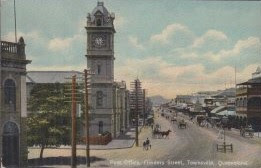When Queensland became a colony separate from New
South Wales (1859) its existing post offices had already been allocated
numerical identification codes for canceling stamps. The practice continued
and, as new post offices opened, each was given its own defining numeral
cancel. Queensland’s numbers range from
5 to 896, with gaps, and continued in use until 1915. The numbers have
surrounds, rays or bars, that vary somewhat. These have been meticulously
identified by Dr Jeremy Hodes and can be viewed online at
https://queenslandstampnumerals.blogspot.com/.
Collecting these cancels, although a well-developed
specialization, can be an interesting diversion for generalists. Most
collections will have some of them. If the number is clear enough to read, one
can easily find out a great deal about the post office and town where the stamp
got branded. Two examples from my collection follow.
Laidley, a rural town in
the Lockyer Valley region, began in the early 1830s as a wagon stop on the way
from Ipswich and Toowoomba. It opened its post office in 1861 and was assigned
the number 32. Although small (Laidley’s population today is shy of 4000), a
major railway passed through it giving its postal service greater importance
than it would have had otherwise.
Gordon Davenport has collected pictures of old Laidley, including its post office, some of which can be viewed at:
https://www.pinterest.com.au/pin/1901-laidley-post-office--105201341272092445/
A costal city, Townsville
was founded in 1864 and, because of its proximity to gold mining areas, it developed
into the main city of North Queensland. Its cancel number is 59. In 2021, its
population exceeded 179,000.
With comparatively few
stamp designs to choose from (commonly called the Chalon, Sideface and
Commonwealth varieties), Queensland stamp enthusiasts have largely turned to
the plethora of cancels. Their choice is a good one; it combines interesting
history and geography with their philately.
Census: in BB spaces, 34,
tip-ins 2, on supplement pages 44.
Overall, Queensland stamps are fairly complicated with multiple watermarks, paper, perforation and printing types. Queensland stamps are a good realm for the specialist, less so for the generalist.











No comments:
Post a Comment